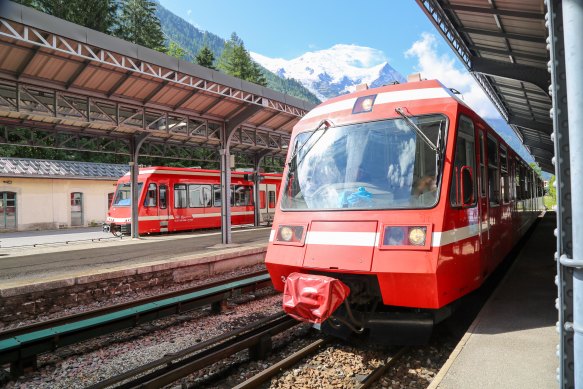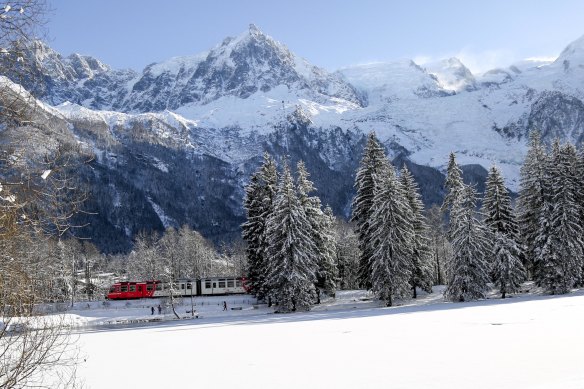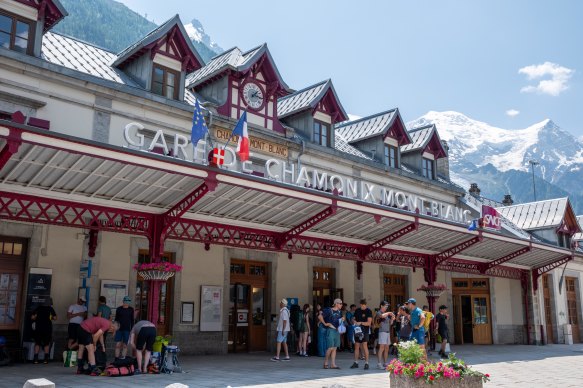It’s not fast or smooth, but this European train is a holiday highlight
By Flip Byrnes
TRAIN REVIEW: The Mont Blanc Express
- The route Martigny, Switzerland, to Chamonix, France
- Distance/time 38 kilometres/1 hour, 38 minutes
- Operators TMR, Switzerland & SNCF, France
- Class One class, no seat reservations
- Frequency 12 services daily

The Mont Blanc Express at the station in Chamonix.
The journey
From Martigny on the valley floor of Switzerland’s Valais Canton up to Chamonix Mont Blanc in France. Despite the name, it’s no fast dash on this narrow gauge railway dating back to 1901. It’s actually two well-co-ordinated train services run by Swiss and French operators; of the 38 kilometres, 18 are in Switzerland and 20 in France, with a train change midpoint in Vallorcine. With the ticket valid for 24 hours, hopping on and off is encouraged, visiting sites like the Marconi Museum in Salvan or the picturesque village of Trient. Note – this is no smooth operator, the slow ascents and descents are both excitingly noisy and jolting.

The train moving through the winter landscape.
The class
Just one class and no seat reservations. For more than a century, the Mont Blanc Express has been the key public transport connection between Chamonix and nearby Switzerland. Far from being just a people mover, it doubles as one of the world’s most spectacular railways, cutting through gorges, below glaciers and tootling past alpine hamlets via six bridges, five viaducts, 21 tunnels and 16 avalanche galleries (which provide overhead protection).
Boarding
If you’re transferring from another service at Martigny (from Geneva, for example), the change will more than likely be simple and almost certainly running to schedule. The station is close to the centre of Martigny with cafes, bars and shops nearby. For this service, the CH80 ($140) fare for myself and two children makes my eyes water – it’s more than the 550-kilometre train journey from Frankfurt to Martigny we’ve connected from.

Summer visitors at the station in Chamonix.
The seat
There’s a single aisle and pairs of seats either side, mostly set up in fours – two facing the direction of travel, two looking back. Even if you miss a window seat, fear not – the huge picture and overhead windows mean even aisle seats offer riveting vistas of mountain scenery and pretty mountain villages and village life. It’s hard not to admire what was involved in creating this engineering marvel as it moves through the neck-craning landscape.
Baggage
As this train is used by commuters, sightseers and adventure seekers (hikers and climbers in summer, skiers and ski tourers in winter), there’s an odd assortment of luggage, everything from picnic baskets to rucksacks, ice axes and skis. Luggage space is ample and restrictions on the amount of it seemingly absent.
Food + drink
There is none, so bring your own from the Martigny station (at Swiss prices) or plan for a delectable lunch at Chambre Neuf upon arrival, just across the way from the Chamonix Mont Blanc train station.
Carbon emissions
Powered by two local hydroelectric plants (which enabled the train to initially abandon steam and handle steeper gradients), the train produces no direct carbon emissions.
One more thing
The terminus of the Mont Blanc Express is St Gervais, another 45 minutes from Chamonix into France and our final destination. We use the ticket’s 24-hour validity to pause overnight in Chamonix, exploring this famed mountain town. The route is also covered on the Swiss Rail Pass (swiss-pass.ch), or the Eurail Pass (eurail.com) but counted as travel days, not distances. The pass would’ve almost earned its keep on this day alone (children under 11 travel free) – I’ll purchase it next time.
The verdict
The Mont Blanc Express was momentous. A few years after its opening, visitation to Chamonix increased sevenfold, changing it forever from sleepy town to global mountain player. It’s still the public transport backbone of the region and is an absolute holiday highlight. See mont-blanc-express.ch
Our rating out of five
★★★★½
The writer travelled at her own expense.
Sign up for the Traveller newsletter
The latest travel news, tips and inspiration delivered to your inbox. Sign up now.